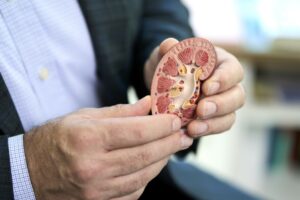- Business Innovation
- Client Stories
- Executive Profiles
- IQ Insigniam Quarterly® Magazine
- Leadership for the Next Digital Age
Engineering a Biotech Breakthrough
In 1667, the first documented xenotransfusion—a form of transplantation defined as the transfer of blood from one species into another—was performed in Paris, France. This process, which transfused lamb’s blood into a human patient, laid the groundwork for the first xenotransplantation—the process of transplanting organ tissue from an animal into a human—in 1906.
In the 118 years that followed, numerous xenotransplantations were performed around the world, utilizing a variety of organs, from sheep and baboon kidneys to chimpanzee hearts.
However, despite steady scientific improvements, all attempts for long-term success in xenotransplantation proved inadequate, as these transplants took place when the immunologic and molecular mechanisms of organ rejection were not well understood. As researchers would discover, success depended on more than just surgical technique; the greatest challenge was the risks of infection in organ recipients.
Elaborating on the challenges in A Brief History of Xenotransplantation, published by The Annals of Thoracic Surgery, researchers note that “Porcine (pig) endogenous retroviruses were discovered in 1994, and had the potential to be transmitted to a human recipient. In 1997, the U.S. Food and Drug Administration (FDA) put a moratorium on all clinical trials until it could be proven that these infections could be detected in recipients. Then, in 1999, the FDA banned primate organ use in xenotransplantation because the risk of infection was so high.”
As science progressed throughout the early 21st Century, numerous advances in immunosuppression and genetic modification progressively overcame barriers that previously hindered xenotransplantation. Also, by this time, multiple cross-species applications had been successful, such as pig dopamine-producing cell transplants to treat Parkinson’s disease, pancreatic pig islet cell transplants for diabetes patients, and decellularized porcine and bovine heart valves for cardiac surgery.

However, the most consequential advancement came in 2013, when the first method to genetically engineer CRISPR—a bacterial defense system that forms the basis of genome-editing technologies—provided researchers with a pathway to permanently modify genes in living cells and organisms.
Then, on March 21, 2024, a true breakthrough was achieved when eGenesis, a biotechnology company focused on developing human-compatible engineered organs, announced the first transplantation of a genetically engineered pig kidney into a living human recipient.
As the world heralded the transplant as a major scientific breakthrough, behind the scenes, a multitude of factors had to fall into place for the historic transplant to be successful.
For instance, the FDA authorized the transplant under the Expanded Access pathway, which “affords patients with immediate life-threatening diseases access to investigational medical products for treatment outside of clinical trials when no comparable or satisfactory alternative therapy options are available,” the agency says.
The patient, Richard Slayman, 62, had previously undergone a kidney transplant from a human donor after spending seven years on dialysis. Unfortunately, the transplanted kidney began to fail about five years later. Due to repeated complications with his bloodstream, Mr. Slayman could no longer continue dialysis treatments.
The surgery, performed at Massachusetts General Hospital, marked a pivotal milestone in the field of transplantation, illustrating the power of collaboration to address the critical issue of global organ shortage.
“This successful procedure heralds a new era in medicine in which we have the potential to eliminate organ supply as a barrier to transplantation and realize our vision that no patient dies waiting for an organ,” said Michael Curtis, Ph.D., president and chief executive officer of eGenesis in a statement following the procedure.
“We are humbled by the courage and generosity of Mr. Slayman, who is a true pioneer, enabling this major breakthrough in science and transplant medicine.”
In his announcement, Dr. Curtis was especially mindful of the incredibly long journey that resulted in the successful breakthrough—one that resulted in eGenesis recently being named one of TIME Magazine’s 100 Most Influential Companies of 2024.
“Decades of progress in cross-species transplantation, accelerated by the advancement of modern genome editing tools and next-generation sequencing, have enabled eGenesis to progress genetically engineered organs to the clinical setting.”
Solving a Global Crisis
To fully appreciate the transformative impact that could result from eGenesis’ breakthrough in the realm of xenotransplantation, we must first understand the nature of the global organ transplant crisis.
Although transplantation is considered the gold standard treatment for improving quality of life and outcomes for those in need, demand for organs far exceeds supply.
Currently, over 100,000 individuals are on the kidney waitlist, and only about 25,000 kidney transplants are performed each year. eGenesis’ development of human-compatible donor organs represents a significant breakthrough needed to reduce waitlist mortality and address the critical shortage of transplantable organs.
“Despite the success of organ transplantation, there are not enough organs to meet the demand, resulting in a typical wait time of about four years,” says Dr. Curtis, speaking to IQ from eGenesis’ corporate offices in Cambridge, Massachusetts. “Patients with end-stage renal disease are often excited to be listed but soon realize the lengthy journey ahead.”
Efforts to increase organ donation, both cadaveric and living, have been ongoing for decades but are insufficient to close the gap, says Dr. Curtis. For heart and liver transplants, there are no true living donor options, and the wait lists under-represent the actual need.
Additionally, over 400,000 patients with end-stage renal disease are on chronic dialysis, all of whom could benefit from a transplant. Unfortunately, these patients often do not improve and spend their lives on dialysis or waiting for a transplant, highlighting a much greater unmet need than the waitlists suggest.
“All told, this means about 20 people die each day awaiting an organ transplant in the US alone,” says Dr. Curtis. “Without new options for patients with organ failure, transplant waiting lists will continue to grow, and more patients will die while waiting—and more will suffer—due to current suboptimal alternatives to transplantation.”

In light of the ongoing organ shortage, xenotransplantation offers an inventive approach to potentially solving the staggering supply-demand gap that is only continuing to increase.
“From the early days when physicians recognized that people were dying from organ failure, the first idea was xenotransplantation, or cross-species transplantation, and this idea persisted even after human-to-human transplantation became possible,” says Dr. Curtis.
Early attempts involving non-human primates, like chimpanzees, were not very successful and posed ethical and practical challenges. As scientists discovered, chimpanzees could be difficult to work with, grow slowly, and there’s a high risk of disease transmission, such as HIV, from closely related primate species.
As researchers looked for alternative animal donors, they began focusing on organ size compatibility and the ability to modify the animals for better transplant success. Thus, pigs emerged as the best option.
“Over the past 40 years, human transplant surgeons have been investigating how to improve the compatibility of pig organs with humans and non-human primates,” says Dr. Curtis. “Through decades of research, it was discovered that genetic modifications could significantly enhance compatibility, leading to long-term transplant outcomes in monkeys.”
However, in the 1990s, it was discovered that all pig breeds carry endogenous retroviruses—which are similar to HIV—within their genome, raising concerns about retroviral transmission to humans, especially under immunosuppression. Many countries imposed a moratorium on cross-species transplants into humans due to this risk.
“Each pig genome contains 50 to 70 copies of these viruses among its 30 billion bases, making it difficult to remove them until the advent of CRISPR-Cas9,” says Dr. Curtis. “This technology enabled precise genome editing, allowing us to inactivate all copies of the retroviruses, thus eliminating the risk to human health.”
At eGenesis, Dr. Curtis and team have integrated 30 years of advancements in understanding the compatibility of pig organs with human recipients. The organ donor used for Mr. Slayman’s transplant had 69 genome edits: 59 to inactivate the retroviruses, three to reduce hyperacute rejection, and seven to promote long-term graft survival.
“This progress builds on decades of foundational research, and eGenesis has been able to consolidate these discoveries into a single organ donor over the past seven years,” says Dr. Curtis.
On April 4, a mere two weeks following his xenotransplant, Mr. Slayman was discharged from Massachusetts General Hospital, an incredibly momentous and critical milestone representing a huge win for an emerging piece of technology that could solve the organ crisis.

“This moment—leaving the hospital today with one of the cleanest bills of health I’ve had in a long time—is one I wished would come for many years. Now, it’s a reality and one of the happiest moments of my life,” Mr. Slayman said in a statement released from Massachusetts General Hospital.
Sadly, on May 11, 2024, Mr. Slayman passed away due to health complications that appear unrelated to his xenotransplant, such as cardiovascular disease, hyperlipidemia, and hypertension; all of which are not uncommon for patients with end-stage renal disease.
“I’ve had many meaningful conversations with individuals at the company about Mr. Slayman receiving this remarkable kidney and his subsequent passing over those 51 days,” says Dr. Curtis. “People feel proud of what we were able to offer him, and while this wasn’t the outcome we hoped for, it’s a significant step forward. Importantly, Mr. Slayman’s loved ones have expressed that continuing this work in his honor is what they hoped for, and we couldn’t be prouder to do just that.”
Pioneering a New Frontier
At the forefront of a new scientific frontier, eGenesis’ advancements in xenotransplantation integrate multiple Nobel Prize-worthy breakthroughs, transforming theoretical possibilities into clinical applications.
This intricate and collaborative process, involving experts in molecular biology and traditional agriculture, showcases eGenesis’ innovative spirit and scientific prowess.
“The willingness to try something new is crucial,” says Dr. Curtis. “When George Church and his team at Harvard suggested using CRISPR-Cas9 to inactivate retroviruses that had concerned researchers for 20 years, many doubted it could be done. However, they successfully figured out how to apply CRISPR-Cas9 within the pig genome, reinventing what was once deemed impossible.”
After licensing the technology from Harvard, eGenesis aimed to incorporate it into clinical applications. This process began with making CRISPR edits to inactivate retroviruses, which entailed screening nearly 8,000 clones to find the correct genotype—a daunting task few entities can accomplish.
Once the edited cells were obtained and collected, the next step was transferring them into pigs through a process called ‘somatic cell nuclear transfer,’ similar to the process used to clone the sheep Dolly in the 1990s.
Ultimately, this highly complex process resulted in the creation of an embryo, which was then transferred to a surrogate pig. There, the organ grew until it could be harvested for transplant in a human patient.
“This process incorporates several scientific breakthroughs, including CRISPR and cloning,” says Dr. Curtis. “After creating the modified piglets, the next challenge was testing them in transplants using non-human primates, which only a few laboratories in the world can do.”
In a kidney transplant model, the native kidneys of a monkey are replaced with a single porcine kidney, and the animal must be managed for up to two years post-transplant.
“Our longest surviving pig kidney transplant in a monkey lasted 758 days, demonstrating the extensive commitment required,” says Dr. Curtis. “At a high level, the process involves editing the genome with 69 edits, cloning the edited cells into pigs, and performing non-human primate transplants—all to gather data supporting readiness for clinical trials.”
As Dr. Curtis notes, each step is intricate and demands continuous optimization and learning.
“Initially, the longest pig kidney transplants in non-human primates lasted around 100 days, but now we see survival times extending well beyond 400 days. The level of science and the diversity of expertise involved in this project are unparalleled, and it requires collaboration among molecular biologists, embryologists, cloning specialists, and transplant biologists.”
To Dr. Curtis’ point, the team at eGenesis includes high-end CRISPR engineers located in Cambridge and a research farm in the Midwest for pig production. This unique combination of advanced science and traditional agriculture showcases the project’s breadth and is essential for overall program success.
“Our work represents a truly interesting mix of expertise, technologies, and experiences—and you need them all,” says Dr. Curtis. “There’s nowhere you can fall short. You need everyone to make this happen.”
Securing the Dream
Beyond harnessing the capabilities of cutting-edge science, another challenge that the eGenesis leadership team has been forced to contend with is the process of securing capital.
As a non-publicly traded company, eGenesis must convince investors not only of scientific feasibility but also of the near-term potential for real-world impact.
“Every company faces challenges, and for us, convincing both patients and investors that we’re ready for primetime is a major one,” says Dr. Curtis. “Investors understand the unmet need and are impressed by the high level of science we achieve. However, their main question remains: how close are we to helping people? Are we still two decades away, or are we within two years of a breakthrough? I believe that as we gather more evidence, investors are more likely to be convinced that we are closer to our goal of solving the global organ transplant crisis.”
Dr. Curtis also notes that Mr. Slayman’s transplant taught the company several crucial lessons—which are not only of interest to the company’s investor audience, but also help eGenesis further diversify the xenotransplant use-cases—which they may soon be able to offer patients.
“Given the significant capital needs of a business model such as ours and the interest among a broad set of potential public investors, we anticipate pursuing an initial public offering within the next several years,” adds Jennifer Bergheiser, chief business officer at eGenesis, who’s 20 years of experience in the biopharmaceutical sector includes venture investing. “To date, the investors that have been a strong fit for eGenesis have been groups that have a long-term horizon and understand that groundbreaking technologies take longer to advance to market.”
Of interest to investors is eGenesis’ strategy to ensure long-term success and sustainability in the market. Based on her experience with commercial product development at companies like Johnson & Johnson, Ms. Bergheiser says the company is focused on portfolio breadth and ensuring that products offer utility and value to patients, clinicians, and the healthcare system overall.
“Our focus initially will be on ensuring that we achieve a clear value proposition for our first-generation products,” says Ms. Bergheiser. “Longer term, we will look to expand our value proposition to address the lifelong burden of immunosuppression that transplant recipients face.”
Dr. Curtis adds, “Our groundbreaking transplant demonstrated eGenesis’ ability and responsibility to this technology to patients in dire need,” he says. “Mr. Slayman had very limited options, most of which would have resulted in his passing. This scenario is analogous to patients facing liver failure and heart failure.”
Broadening said portfolio, eGenesis developed a liver perfusion program aimed at bridging patients in liver failure to recovery. Similarly, the company’s pediatric heart transplant program seeks to bridge children in end-stage heart failure to human transplants. This approach aligns with their concept of compassionate use, prompting eGenesis to explore the utility of products across these three different organ types.
“Achieving this will require more transplants and studies similar to the one we conducted with Mr. Slayman,” says Dr. Curtis. “Over the next 12 to 24 months, we aim to apply our findings across these three programs, continually advancing toward a viable solution for organ failure.”
The Art & Science of Leadership
In their pathway to achieving the unprecedented, the team at eGenesis faced numerous personal and professional challenges that required steadfast leadership from Dr. Curtis and company.
“As we moved into patient trials for the first time, the years of commitment from our team became increasingly evident,” says Dr. Curtis. “By the time we transported our first donor animal from the Midwest to Massachusetts for the initial transplant, the dedication of our team was palpable.”
Dr. Curtis notes that the eGenesis team devoted countless hours, including overnights and weekends, living alongside the donor animal every day for a year. This close bond made the animal almost part of the team, and witnessing it being prepared for transplantation was an emotional experience, filled with pride and sadness.
“The team’s hard work and the animal’s journey culminated in this moment, highlighting the future possibilities for xenotransplantation,” says Dr. Curtis. “This first transplant was a powerful testament to the incredible dedication and emotion driving our efforts at eGenesis.”
Specializing in building biotech teams that move the needle on human health, eGenesis’ Chief People Officer, Elizabeth Roberts, says the company’s growth trajectory has very much influenced her pragmatic approach to people development within the organization.
“Over the years, we have learned a great deal about the challenges of expanding our operations,” says Ms. Roberts. “When I joined eGenesis six years ago, we didn’t start with multiple sites and numerous animals; rather, our growth has necessitated constant evolution. Furthermore, our foundation rests on an inherent willingness to explore possibilities. It would have been easy to give up at any of the countless obstacles we faced, but instead, we chose to engage fully.”
In keeping people engaged through numerous setbacks and challenges throughout the scientific process, Ms. Roberts notes that the magic of eGenesis’ work happens across a hundred-member team spread over four sites in three states, encompassing various disciplines. Thus, recruiting and retaining a world-class team has been crucial.
“We need the world’s leading experts in various fields, but expertise alone isn’t enough,” she says. “Gene editing, while vital, is only one part of xenotransplantation, just as embryology is another critical component. Our success relies on what I call scientific generosity—an intellectual curiosity and willingness to collaborate. These are core values at eGenesis.”
Ms. Roberts says it is imperative to seek out people who can blend their expertise with a collaborative spirit.
“It’s not about the pedigree or where you got your degree; it’s about how well you can work with colleagues from different disciplines,” she elaborates. “Dr. Curtis often emphasizes this: from gene editing to caring for the animals, our work is a culmination of years of dedication from many people. Keeping everyone focused on the broader goal of xenotransplantation is essential. Each task, no matter how small, contributes to the bigger picture. This collaborative effort is what we strive for every day.
Catalyzing a Bold New Future
As evidenced by their incredible breakthrough, eGenesis stands as a beacon of bold decision-making and relentless perseverance. Their journey, epitomized by the pivotal transplant of Mr. Slayman, offers invaluable lessons for executives navigating uncharted territories.
“One of the key lessons from our journey, exemplified by Mr. Slayman’s transplant, is the importance of challenging assumptions,” says Dr. Curtis. “We undertook his transplant in March because we finally asked the right questions that led us to that point. In retrospect, we might have been able to do it earlier, but we didn’t because we assumed the regulatory agencies would deny our request.
We talked ourselves out of trying, fearing rejection.”
Eventually, says Dr. Curtis, eGenesis decided to make their best case, thinking, “If they say no, they say no, but maybe they’ll say yes.” To the company’s delight, the FDA gave clearance via an Expanded Access use case. The experience was eye-opening for Dr. Custis and team, who realized they had been holding themselves back by not challenging assumptions.
“Dr. Curtis and the team at eGenesis perfectly demonstrate that groundbreaking innovation often requires questioning the status quo and daring to defy conventional wisdom,” says Insigniam partner Jon Kleinman, who has worked closely with the executive team for several years, witnessing how their relentless pursuit of excellence has pushed the boundaries of what’s possible.“By envisioning the end goal of solving the organ transplant crisis and then working backward from that future state, eGenesis has paved a path towards transformative breakthroughs in transplantation science.”
From his vantage point, Dr. Curtis agrees.
“This experience taught us to thoroughly examine and question the reasons behind our decisions, especially in innovative areas,” he says. “By questioning assumptions and considering all possibilities, we can make more informed and bold decisions. This mindset has become a fundamental part of our approach at eGenesis, driving us to continuously push the boundaries of what we can achieve.”



